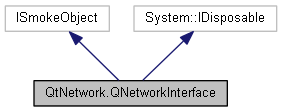|
Qyoto
4.0.5
Qyoto is a C# language binding for Qt
|
|
Qyoto
4.0.5
Qyoto is a C# language binding for Qt
|
The QNetworkInterface class provides a listing of the host's IP addresses and network interfaces. More...


Public Types | |
| enum | InterfaceFlag { CanBroadcast = 4, CanMulticast = 32, IsLoopBack = 8, IsPointToPoint = 16, IsRunning = 2, IsUp = 1 } |
| More... | |
Public Member Functions | |
| QNetworkInterface () | |
| | |
| QNetworkInterface (QNetworkInterface other) | |
| | |
| virtual void | CreateProxy () |
| new System.Collections.Generic.List < QNetworkAddressEntry > | AddressEntries () |
| | |
| new QNetworkInterface.InterfaceFlag | Flags () |
| | |
| new string | HardwareAddress () |
| | |
| new string | HumanReadableName () |
| | |
| new int | Index () |
| | |
| new bool | IsValid () |
| | |
| new string | Name () |
| | |
| new void | Dispose () |
Static Public Member Functions | |
| static System.Collections.Generic.List < QHostAddress > | AllAddresses () |
| | |
| static System.Collections.Generic.List < QNetworkInterface > | AllInterfaces () |
| | |
| static QNetworkInterface | InterfaceFromIndex (int index) |
| | |
| static QNetworkInterface | InterfaceFromName (string name) |
| | |
Protected Member Functions | |
| QNetworkInterface (System.Type dummy) | |
Protected Attributes | |
| SmokeInvocation | interceptor |
Properties | |
| virtual System.IntPtr | SmokeObject [get, set] |
The QNetworkInterface class provides a listing of the host's IP addresses and network interfaces.
QNetworkInterface represents one network interface attached to the host where the program is being run. Each network interface may contain zero or more IP addresses, each of which is optionally associated with a netmask and/or a broadcast address. The list of such trios can be obtained with addressEntries(). Alternatively, when the netmask or the broadcast addresses aren't necessary, use the allAddresses() convenience function to obtain just the IP addresses.
QNetworkInterface also reports the interface's hardware address with hardwareAddress().
Not all operating systems support reporting all features. Only the IPv4 addresses are guaranteed to be listed by this class in all platforms. In particular, IPv6 address listing is only supported on Windows XP and more recent versions, Linux, MacOS X and the BSDs.
See also QNetworkAddressEntry.
Specifies the flags associated with this network interface. The possible values are:
Note that one network interface cannot be both broadcast-based and point-to-point.
|
protected |
| QtNetwork.QNetworkInterface.QNetworkInterface | ( | ) |
Constructs an empty network interface object.
| QtNetwork.QNetworkInterface.QNetworkInterface | ( | QNetworkInterface | other | ) |
Creates a copy of the QNetworkInterface object contained in other.
| new System.Collections.Generic.List<QNetworkAddressEntry> QtNetwork.QNetworkInterface.AddressEntries | ( | ) |
Returns the list of IP addresses that this interface possesses along with their associated netmasks and broadcast addresses.
If the netmask or broadcast address information is not necessary, you can call the allAddresses() function to obtain just the IP addresses.
|
static |
This convenience function returns all IP addresses found on the host machine. It is equivalent to calling addressEntries() on all the objects returned by allInterfaces() to obtain lists of QHostAddress objects then calling QHostAddress::ip() on each of these.
|
static |
Returns a listing of all the network interfaces found on the host machine.
|
virtual |
| new void QtNetwork.QNetworkInterface.Dispose | ( | ) |
| new QNetworkInterface.InterfaceFlag QtNetwork.QNetworkInterface.Flags | ( | ) |
Returns the flags associated with this network interface.
| new string QtNetwork.QNetworkInterface.HardwareAddress | ( | ) |
Returns the low-level hardware address for this interface. On Ethernet interfaces, this will be a MAC address in string representation, separated by colons.
Other interface types may have other types of hardware addresses. Implementations should not depend on this function returning a valid MAC address.
| new string QtNetwork.QNetworkInterface.HumanReadableName | ( | ) |
Returns the human-readable name of this network interface on Windows, such as "Local Area Connection", if the name could be determined. If it couldn't, this function returns the same as name(). The human-readable name is a name that the user can modify in the Windows Control Panel, so it may change during the execution of the program.
On Unix, this function currently always returns the same as name(), since Unix systems don't store a configuration for human-readable names.
This function was introduced in Qt 4.5.
| new int QtNetwork.QNetworkInterface.Index | ( | ) |
Returns the interface system index, if known. This is an integer assigned by the operating system to identify this interface and it generally doesn't change. It matches the scope ID field in IPv6 addresses.
If the index isn't known, this function returns 0.
This function was introduced in Qt 4.5.
|
static |
Returns a QNetworkInterface object for the interface whose internal ID is index. Network interfaces have a unique identifier called the "interface index" to distinguish it from other interfaces on the system. Often, this value is assigned progressively and interfaces being removed and then added again get a different value every time.
This index is also found in the IPv6 address' scope ID field.
|
static |
Returns a QNetworkInterface object for the interface named name. If no such interface exists, this function returns an invalid QNetworkInterface object.
See also name() and isValid().
| new bool QtNetwork.QNetworkInterface.IsValid | ( | ) |
Returns true if this QNetworkInterface object contains valid information about a network interface.
| new string QtNetwork.QNetworkInterface.Name | ( | ) |
Returns the name of this network interface. On Unix systems, this is a string containing the type of the interface and optionally a sequence number, such as "eth0", "lo" or "pcn0". On Windows, it's an internal ID that cannot be changed by the user.
|
protected |
|
getset |